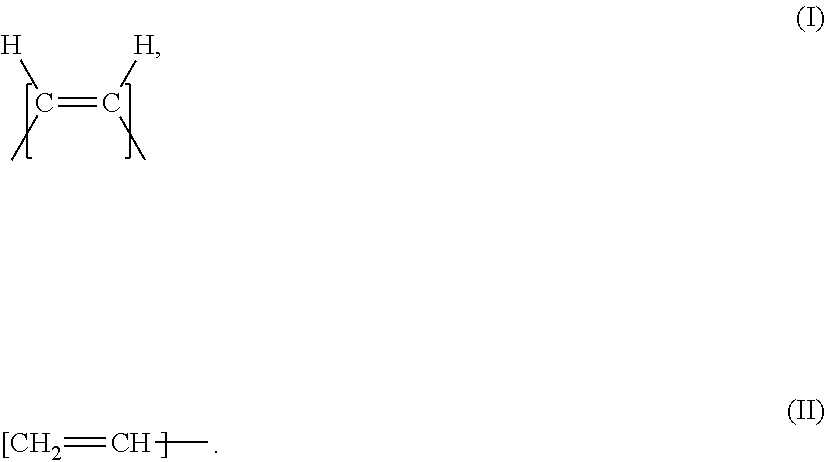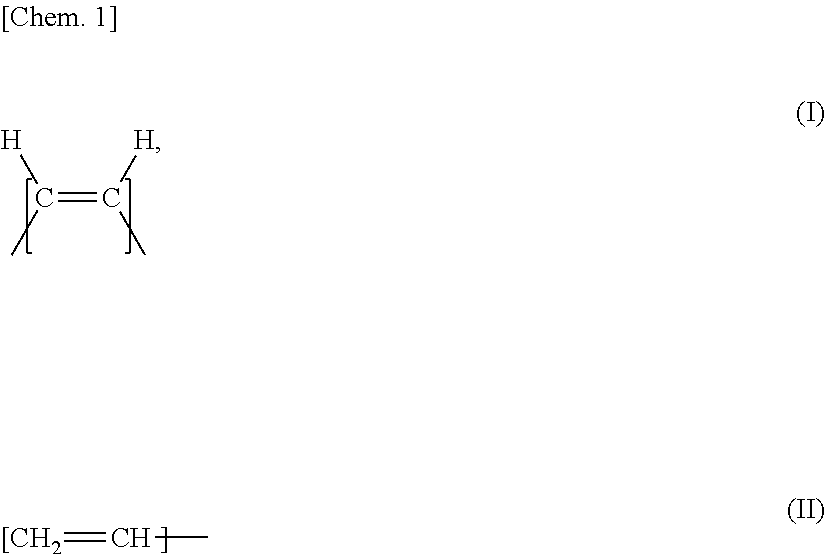Ethylene/alpha-olefin/non-conjugated polyene copolymer, and production process and use thereof
a technology of alpha-olefin and polyene, which is applied in the field of ethylene/olefin/non-conjugated polyene copolymer, can solve the problems of large long-chain branch content of ethylene copolymer obtained by these techniques, unsuitable for obtaining a shape, and poor processability of copolymer during its formation and physical properties, etc., to achieve excellent crosslinking properties, small long-chain branch conten
- Summary
- Abstract
- Description
- Claims
- Application Information
AI Technical Summary
Benefits of technology
Problems solved by technology
Method used
Image
Examples
example 1
(Production of Ethylene-Propylene-VNB Copolymer (A))
[0587]Into a continuous polymerizer of 1 L in volume made of SUS via a supply port thereof were continuously added dehydrated and purified hexane at a rate of 1.5 L / h, a hexane solution (5 mmol / L) of triisobutylaluminum at a rate of 0.1 L / h (0.5 mmol / h), a hexane solution (0.01 mmol / L) of di(p-chlorophenyl)methylene (cyclopentadienyl) (octamethyloctahydrodibenzofluorenyl) zirconium dichloride (E1 in Table 1) at a rate of 0.03 L / h (0.0003 mmol / h), and a toluene solution (0.025 mmol / L) of triphenylcarbenium tetrakis(pentafluorophenyl)borate (E3 in Table 1) at a rate of 0.06 L / h (0.0015 mmol / h). Simultaneously via another supply port of the polymerizer were continuously added ethylene at a rate of 50 g / h, propylene at a rate of 40 g / h, 5-vinyl-2-norbornene (VNB) at a rate of 3.2 g / h, and hydrogen at a rate of 0.25 NL / h to fill the polymerizer with the liquid phase, and continuous polymerization was carried out under a condition of a p...
examples 2 to 13
(Production of Ethylene / Propylene / Non-Conjugated Polyene Copolymers (B) to (M))
[0596]Ethylene / propylene / non-conjugated polyene copolymers (B) to (M) were each produced in the same manner as in Example 1 except that the kind of catalysts used for copolymerization, the kind and amount of monomers introduced in the polymerizer were changed as shown in Table 1. Physical properties of each obtained copolymer are shown in Table 1. In the table, ENB means ethylidene norbornene.
[0597]In Table 1, the abbreviations for catalyst mean the following compounds.[0598]E1: di(p-chlorophenyl)methylene(cyclopentadienyl)(octamethyloctah ydrodibenzofluorenyl)zirconium dichloride[0599]E2: di(p-tolyl)methylene(cyclopentadienyl)(octamethyloctahydrodib enzofluorenyl)zirconium dichloride[0600]E3: triphenylcarbenium tetrakis(pentafluorophenyl)borate[0601]MAO: methylaluminoxane
(Production of Crosslinked Shaped Article)
[0602]Rubber blends (B-1) to (M-1) and crosslinked articles (B-2) to (M-2), and (B-3) to (M-3...
preparation example 1
Production of Ethylene-Propylene-VNB Copolymer (S-1)
[0611]Into a continuous polymerizer of 1L in volume made of SUS via a supply port thereof were continuously added dehydrated and purified hexane at a rate of 1.5 L / h, a hexane solution (5 mmol / L) of triisobutylaluminum at a rate of 0.1 L / h (0.5 mmol / h), a hexane solution (0.01 mmol / L) of di(p-chlorophenyl)methylene (cyclopentadienyl) (octamethyloctahydrodibenzofluorenyl) zirconium dichloride at a rate of 0.03 L / h (0.0003 mmol / h), and a toluene solution (0.025 mmol / L) of triphenylcarbenium tetrakis(pentafluorophenyl)borate at a rate of 0.06 L / h (0.0015 mmol / h). Simultaneously via another supply port of the polymerizer were continuously added ethylene at a rate of 50 g / h, propylene at a rate of 38 g / h, 5-vinyl-2-norbornene (VNB) at a rate of 6.1 g / h, and hydrogen at a rate of 0.3 NL / h to fill the polymerizer with the liquid phase, and continuous polymerization was carried out under a condition of a polymerization temperature of 95° C...
PUM
| Property | Measurement | Unit |
|---|---|---|
| weight fraction | aaaaa | aaaaa |
| weight fraction | aaaaa | aaaaa |
| weight fractions | aaaaa | aaaaa |
Abstract
Description
Claims
Application Information
 Login to View More
Login to View More - R&D
- Intellectual Property
- Life Sciences
- Materials
- Tech Scout
- Unparalleled Data Quality
- Higher Quality Content
- 60% Fewer Hallucinations
Browse by: Latest US Patents, China's latest patents, Technical Efficacy Thesaurus, Application Domain, Technology Topic, Popular Technical Reports.
© 2025 PatSnap. All rights reserved.Legal|Privacy policy|Modern Slavery Act Transparency Statement|Sitemap|About US| Contact US: help@patsnap.com



